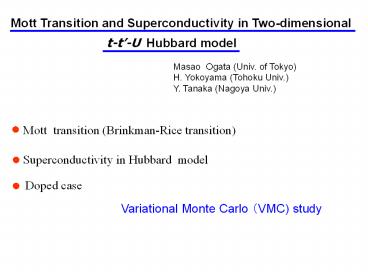Mott Transition and Superconductivity in Two-dimensional - PowerPoint PPT Presentation
1 / 20
Title:
Mott Transition and Superconductivity in Two-dimensional
Description:
Mott Transition and Superconductivity in Two-dimensional t-t -U Hubbard model Masao Ogata (Univ. of Tokyo) H. Yokoyama (Tohoku Univ.) Y. Tanaka (Nagoya Univ.) – PowerPoint PPT presentation
Number of Views:73
Avg rating:3.0/5.0
Title: Mott Transition and Superconductivity in Two-dimensional
1
Mott Transition and Superconductivity in
Two-dimensional
t-t-U Hubbard model
Masao Ogata (Univ. of Tokyo) H. Yokoyama (Tohoku
Univ.) Y. Tanaka (Nagoya Univ.)
Mott transition (Brinkman-Rice transition)
Superconductivity in Hubbard model
Doped case
Variational Monte Carlo (VMC) study
2
Mott transition at half-filling
Doped Mott insulator ----- What is Mott
insulator? t-J model ? Heisenberg
model (d ? 0) We need to study
Hubbard model. Brinkman-Rice
transition doublon number ? 0 at Uc
(second-order phase transition)
ltdgt
However this Brinkman-Rice transition is not
observed in VMC.
Uc
Yokoyama-Shiba, JPSJ (1987)
3
Mott transition at half-filling
Brinkman-Rice transition is not observed in VMC.
ltdgt
E0 for U gtUc
Uc
(Brinkman-Rice)
Yokoyama-Shiba, JPSJ (1987)
Doublon number is always finite.
We modify variational states.
Mott transition as a first-order (like a
liquid-gas phase transition)
4
Superconductivity at half-filling
- Organic conductors k-(BEDT-TTF)2X
X1- , BEDT-TTF 0.5
quarter filling
BEDT-TTF layer
X layer
?-ET
CuO2
t
t
t
t
H. Kino and H. Fukuyama, J.Phys.Soc.Japan 64,
2726 (1995).
If 2 BEDT-TTF molecules form a dimer, it can be
regarded as a single site.
5
Superconductivity in ?-(BEDT-TTF)2X
SC
AF insulator
First order
K. Kanoda
d-wave
pressure U/t is
controled Substitution of X
(not filling control)
insulator ? SC ? metal
Nonmagnetic insulator
SC
Fisrt order
Nonmagnetic down to T32mK
Y. Shimizu et al (NMR)
6
?-ET
CuO2
Superconductivity at half-filling
t
t
t
t
- Organic conductors k-(BEDT-TTF)2X
- Superconductivity
- first-order Mott transition
k-(BEDT-TTF)2CuN(CN)2Br - Also Spin-Liquid state
k-(BEDT-TTF)2Cu2(CN)3 - 2) High-Tc cuprates
T-La2-xRxCuO4 (R Sm, Eu, Gd, Tb, Lu, Y)
Tc21.4K
T -structure
Tsukada et al., SSC 133, 427 (2005)
7
Yokoyama-Ogata-Tanaka Cond-mat/0607470
Motivation for
t-t-U Hubbard model
Mott transition as a liquid-gas phase
transition Superconductivity at half-filling
Effects of t Frustration (AF ?
superconductivity, RVB-Insulator)
We have to study the Hubbard model. So far,
quantum MC is negative, but FLEX gives SC.
Doped case
Weak coupling UltW BCS-like Strong coupling
UgtW t-J like doped Mott insulator
T0 Variational Monte Carlo (VMC) study
8
Modified variational states
Usual Gutzwiller factor
nearest-neighbor doublon-holon correlation
Doublon-holon bound states are favored in wave
functions
9
PQ is important
Mott Transition
bound (µ? 1 )
free (µ? 0 )
conductive
insulating
variational states Fermi sea, d-wave SC,
mean-field AF
First-order Mott transition is realized.
10
half filling (d0)
I. Phase diagram
t-t-U Hubbard model
RVB insulator (Para-insulator with d-wave
order parameter)
d-wave SC
L 10 L 12
11
First-order Mott transition
half filling (d0)
Energy crossing
Doublon density
order parameter of Mott transition (similar to
gas-liquid transition)
d-wave SC
RVB insulator
Uc
12
half filling (d0)
d-wave to RVB insulator
d-wave pair correlation function
d-wave is enhanced at U / t lt 6.5
t / t -0.25
Wave function has d-wave order parameter, but Pd
vanishes.
RVB insulator
Uc
13
Momentum distribution function
nodal point
U lt Uc Fermi surface (metallic) U gt Uc no
Fermi surface (insulator)
14
half filling (d0)
I. Phase diagram
t-t-U Hubbard model
Similar results for triangular lattice
RVB insulator (Para-insulator with d-wave
order parameter)
d-wave SC
L 10 L 12
Gan et al., PRL 94, 067005 (2005)
d-wave SC ?AF (Gutzwiller approx.)
15
less-than-half filling
II. Doped Case
t-t-U Hubbard model
RVB insulator (Para-insulator with d-wave
order parameter)
d-wave SC
L 10 L 12
doping
16
less-than-half filling
II. Doped Case
d 0.12
d-wave pair correlation function for
various values of t
Large U (U gt Uco)
Doped Mott insulator
doublon-holon bound state n.n. doublon-holon
virtual process inducing J-term
t-J region
(Excess holes are mobile)
USI
Small U (U lt Uco) weak-coupling region
17
Condensation energy
1) Small U (U lt USI)
very small DE
DE 10- 4 t at U4t 0.4K
DE Enorm - ESC
PQFS PQBCS
DE e- t / U
consistent with QMC, and weak-coupling theory
2) Intermediate U (USI lt U lt UCO)
abrupt increase of DE
3) Large U (UCO lt U)
large DE
DE e- a U / t e- 4a t / J
consistent with t-J model
18
Result 2 t-dependence
for various values of U / t
d 0.12, 0.14
Large U (U gt Uco) U / t 8 U / t 12
U / t 16
Small U (U lt Uco) U / t 4
t gt 0 -- unfavorable
van Hove singularity
(electron doped)
t - 0.15
High-Tc should be in UgtUco
19
Result 3 doping-dependence
t-J region
weak-coupling region
t -0.1
t -0.1
U / t 8
U / t 4
t -0.3
High-Tc should be in UgtUco (t-J
region) Consistent with Uemuras plot (Tc ? d)
20
Conclusions
- Modified variational state doublon-holon bound
state is important. - Mott transition (half-filling)(Brinkman-Rice)
- Doped case
RVB insulator
Doped Mott insulator
large U (non-BCS)
(t-J region)
(weak-coupling region)
small U (BCS-like)
d-wave SC is enhanced for tlt 0 for U gt Uco
6.5 t
High-TC cuprates belong to the large U region
(non-BCS)
Experimental check
t -dependences (Uemura plot)
Kinetic energy gain (optical sum rule)
large U ----- kinetic energy gain in SC
(non-BCS)
(t-J region)
small U ------ potential energy gain in SC
(BCS-like)

